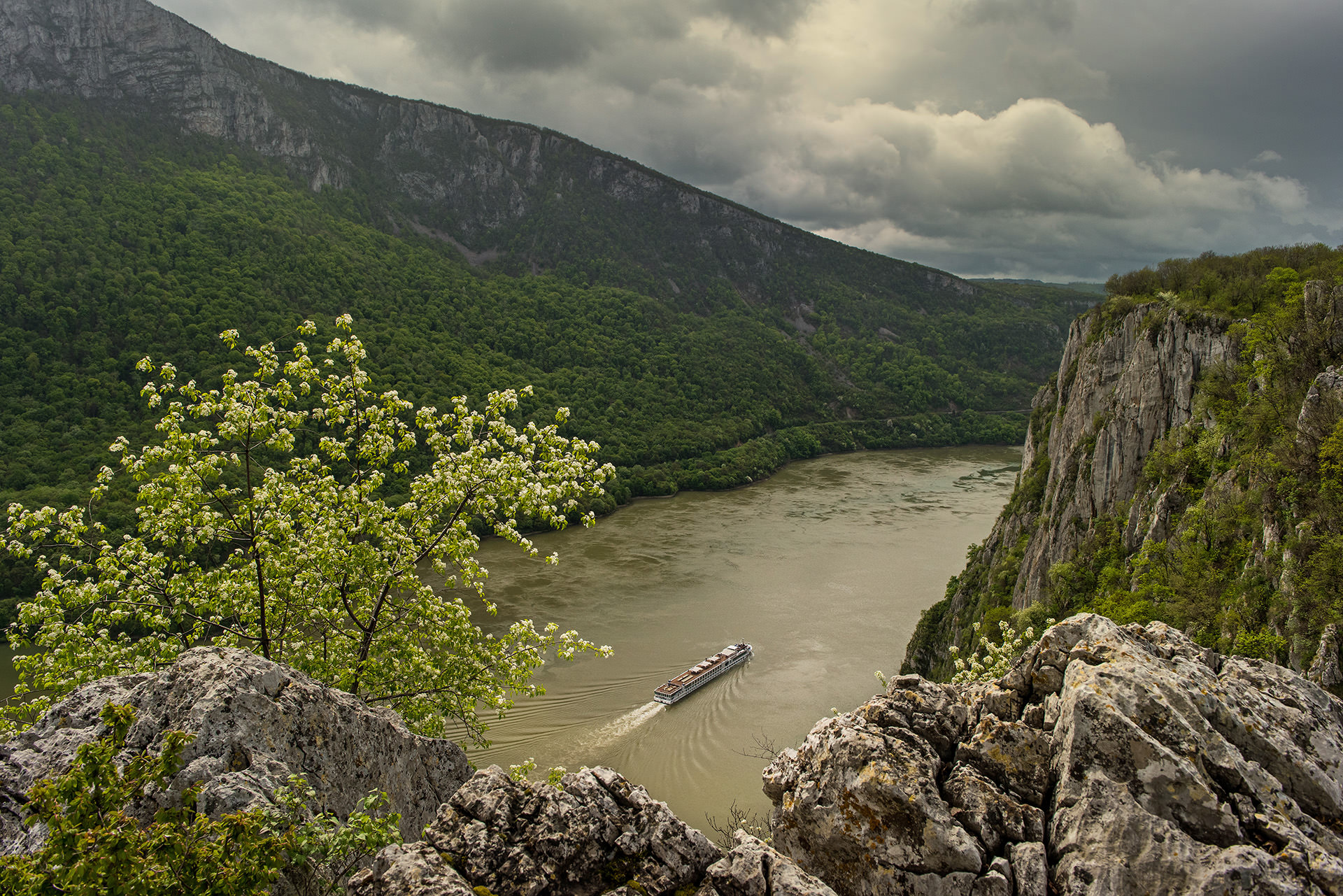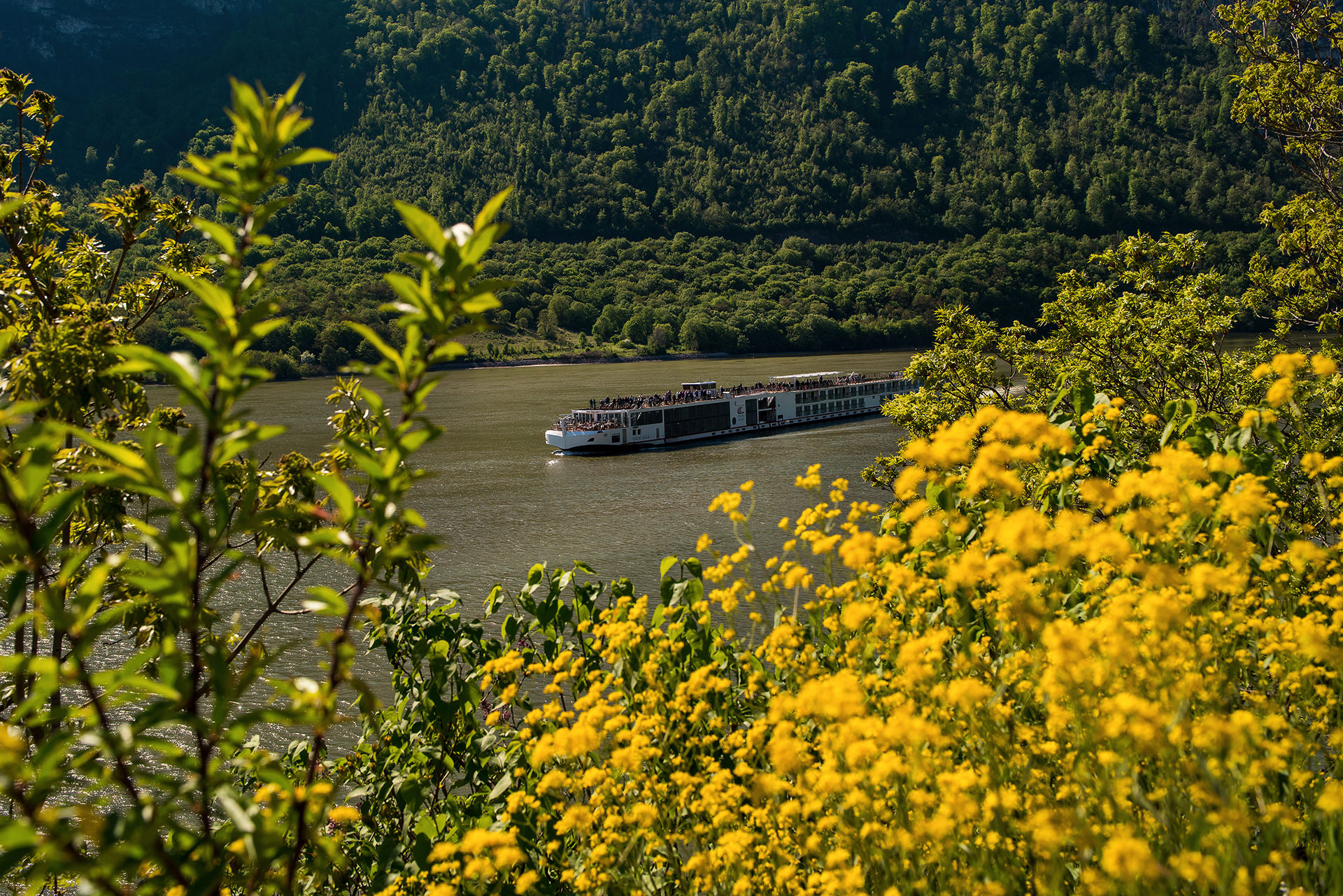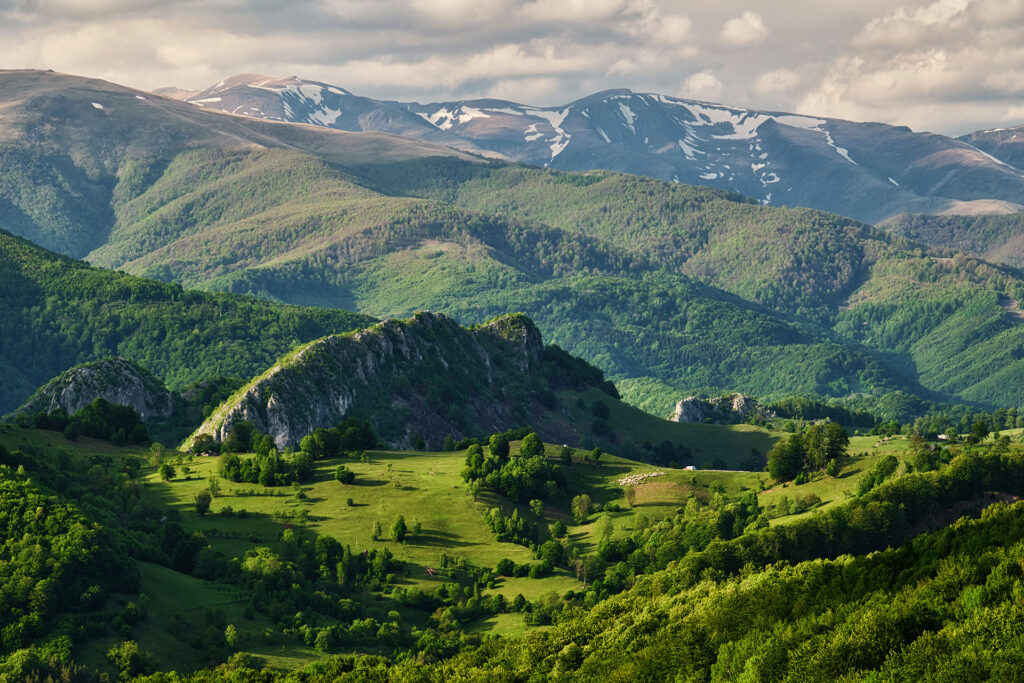As we finally reach the mighty Danube, the landscape changes dramatically, with the emerald ribbon of the tumultuous river caught between the abrupt ridges of the mountains. We hereby enter a magical land (Iron Gates Natural Park) of astonishing scenery teeming with rare and unique life, where the breathtaking sight of the Danube from above is perfectly framed by colorful wildflowers and cheerful birdsong!

Short Intro & Access
Meandering its way across central and southeastern Europe, the Danube creates a myriad of enchanting landscapes. Nevertheless, the most spectacular and impressive of them is the small portion locked between the mountains of Romania and Serbia. Enclosed by the Carpathians and the Balkans, the otherwise peaceful river used to become wild and tormented. After centuries of being the nightmare of sailors that had to try their luck crossing the so-called cauldrons, it was finally tamed after the creation of the impressive Iron Gates hydroelectric complex.
Search for Flights to Romania with Booking.com!
The Iron Gates Natural Park covers the area mostly known as the Danube Defile in southwestern Romania, along the border with Serbia. A destination of immense natural beauty and unique cultural significance, it includes the spectacular defile created by the river and dividing the Carpathian and the Balkan mountains. In Romania, the park includes the southern ridges of the Locvei and Almăj Mountains, as well as small areas of the Mehedinți mountains and plateau. It was created to protect and preserve the splendid landscapes, the unique biodiversity and the multicultural heritage of this fascinating area.


The Iron Gates Natural Park is located in the southwest of the country, along the Danube Defile that forms the natural border with Serbia. The Danube enters Romania near the village of Buziaș and continues for about 250 km up to the first Iron Gates dam and hydroelectric power plant, a few kilometers west of the city of Drobeta Turnu Severin. The park covers the defile and the adjoining mountain ridges in the counties of Caraș-Severin and Mehedinți.

We can start exploring the park along the national Road 57 that follows the river east to west, as well as the several local road and hiking paths branching north into the lower mountains. There is actually an overwhelming number and diversity of attractions inside the park, mostly along the defile of the Danube. Nevertheless, the true highlight of our visit is the small area known as the Cauldrons of the Danube, where the steep mountain ridges get closer together, creating a unique and dramatic scenery.


Iron Gates Natural Park Sights
Before the development of the Iron Gates, this portion of the river was extremely wild and dangerous, with many sharp crags breaching the surface. Other sights we can also admire include the town of Orșova, the monumental Rock Sculpture of Decebalus, the Mraconia, Saint Anne and Vodița monasteries, the Veterani and Ponicova caves, the Tricule Fortress ruins, the Iron Gates Dam and Museum, as well as many tourist hiking paths. Over on the Serbian side, the Djerdap National Park features equally fascinating landscapes and sights.

We begin exploring this exceptional destination from its eastern part, next to the impressive Iron Gates hydroelectric system, just a few kilometers west of the first bridge that the Romans built over the Danube about two millennia ago. One of the largest in Europe, this engineering marvel was created in partnership by Romania and Serbia between 1964 and 1972, raising the river by more than 35 meters.
This completely covered the island of Ada Kaleh and several settlements on the river banks were relocated. The massive dam spans for almost 1.3 kilometers and creates a huge lake that covers an area of over 100 sq. km., up to the entrance of the Danube in Romania, about 150 km to the west. We can also go inside the dam, where the Iron Gates Museum features incredible information about its construction, as well as the opportunity to admire the enormous turbines.


Continuing towards the west, the road starts to hang over the river, frequently passing over bridges and through short tunnels. Just 8 km from the dam, a small gulf hides the enchanting Vodița Monastery, considered the oldest founded by a ruler and the oldest autonomous Orthodox monastery in the country. It was built in the second half of the 14th century by Saint Nicodemus of Tismana with the help of Vladislav I, ruler of Wallachia.
During the following centuries, the monastery experienced flourishing times, when it was an important religious center but also tragic events when it was completely destroyed by the Ottomans. We can only find a few ruins from the old monastery, while the new one was built further inland in 1991, with a new wooden church that resembles the traditional churches of Maramureș region.

After another 10 kilometers along the winding road, we get a first glimpse of the picturesque town of Orșova. Tucked along the gentle slopes of a small hill and overlooking a charming bay, the new town was created during the development of the Iron Gates system, when the river flooded the old town. During ancient times, Orșova was known as the Roman settlement Dierna and was disputed for centuries among local powers. Today, Orșova is a quiet and charming place, with several beautiful sights we can discover.


The enchanting Saint Anne Monastery overlooks the river and the bay from a nearby hill, offering stupendous panoramas and an oasis of tranquility. In the town center, the Roman-Catholic Cathedral of the Immaculate Conception is one of the most unique and futuristic in Romania, with its unusual tent-shape architecture, cross-shaped roof and separate belltower. We can also wander along the promenade of the Danube, charter boat tours or admire the athletes of the national rowing complex.

Leaving Orșova, we quickly arrive at the entrance of the famous Cauldrons of the Danube, two narrow gorge sectors that are also known as Danube’s Boilers. The Big Cauldrons and the Small Cauldrons are just a few kilometers apart, separated by the splendid Gulf of Dubova. Their particular names date back from centuries ago, when they were famous for their dangerous waters with hidden rocks and strong cataracts.


We first enter the Small Cauldrons, with the steep banks of the river just about 150 meters apart, while the depth reaches 100 meters. The Romanian ridge of Ciucaru Mic is just over 300 meters, while the Serbian mountain is over 600 meters. There is a hiking path going to the peak and offering an unforgettable panorama of the area.

The ridge is broken by the small gulf of Mraconia, where we can first be awed by the monumental Rock Sculpture of Decebalus. The huge face of the last king of the Dacians was carved in the mountain, seemingly looking towards the other bank of the river, where the Roman invaders arrived two millennia ago. The Dacian king fought against the Romans at the end of the first century, fending off several attacks before finally being defeated by emperor Trajan.
It is considered the largest stone sculpture in Europe at 55 meters height and 25 meters length, created between 1994 and 2004 by a Romanian businessman. On the other bank of the Danube, there is an ancient sight known as the Trajan’s Plaque or Tabula Traiana. Commissioned by the emperor after the conquest of Dacia, it is the only one preserved of ten that were originally sculpted. Just a few steps further along the road, a small white church is precariously perched over the raging river.


The Mraconia Monastery stands over the ruins of several older ones that were built in the area dating back to the middle of the 15th century. This used to be an old observation point on the Danube, where ships were guided through the treacherous waters of the cauldrons. The last monastery was covered by the river, while the present one was built starting in 1993, featuring one of the most picturesque locations in the country.

Passing through the village of Dubova stretching along the gulf, we then reach the Big Boilers, although the road actually goes around the steep Ciucaru Mare Mountain. The river is 80 meters deep, while the ridges are about 200-250 meters apart, with the Servian side being a lot taller. There is a beautiful hiking path going from the road to the top of Ciucaru Mare mountain, offering some of the most breathtaking belvedere points over the cauldrons and the gulf of Dubova. Inside the ridge, there are two fascinating caves that we can discover.


Although quite small and only accessible by water, Veterani Cave is one of the most unique in Romania. The true highlight is a small opening in the ceiling that lets sun rays in at certain times each day, creating a magnificent and almost ethereal scene. The cave was known and inhabited from ancient times, considered a sanctuary of the Dacian god Zalmoxis. It was also used as a garrison by Austrian troops and there are some ruins of old fortifications inside.
The nearby Ponicova Cave has several entrances from the river and the road, although only experienced and equipped travelers should venture inside. The cave features several galleries on two levels, the lower one being submerged, while the upper one features interesting speleological formations. From Orșova, Mraconia or Dubova, we can also take a boat tour to better experience the Danube Cauldrons area, some of them including the entrance inside the caves.

Continuing beyond the cauldrons, we pass along some amazing places, the river creating exceptional landscapes. A valley between the mountains of Almăj and Locvei hides a lesser-known attraction of the park. The old water mills of Sichevița can be found along the small river, with about 10 wooden mills still preserved from the 30 that once stood in the valley. We can visit this veritable open air museum to discover the unique architecture and mechanisms, while these authentic villages are considered the origin of all Romanian people now living in the Danube Defile.
Further along and about 20 km south of Dubova, we pass by an unusual sight known as the Tri Kule Fortress. The old fortification was built sometime during the 14th or 15th century and used to guard the river. Today, only two of the three towers are still visible and are usually surrounded by water. Further along, we can also admire a majestic peak rising from the forest north of the road. It is actually an old volcanic neck with steep walls known as Trescovăț Ridge, with a fascinating hiking trail reaching its top and offering superb views of the Danube valley.


We are finally getting closer towards the end of the journey, but not before admiring the magnificent fortress rising on the Servian bank of the Danube. The imposing Golubac Fortress is completely renovated today, with its ten tall towers rising above a rock that sometimes resembles an elephant drinking from the river. It had a tumultuous past, resisting over 120 attacks across its history.
We can best admire it from the Romanian side, especially from the small rock where another fortification used to stand. Known as Ladislau Fortress, it is currently being restored to receive visitors and offer superb panoramas of the area. From the village of Coronini, the road continues for about 35 km to the village of Baziaș, close to the entrance of the Danube into Romania and the limit of the Iron Gates Natural Park.

Across this marvelous destination, we can also admire the rich and unique biodiversity, about 80% of the park surface being covered by forests. It has many endemic and rare floral species, like the beautiful Cauldrons Tulip (tulipa hungarica) that only grows on the steep walls of Ciucaru Mare ridge and can be spotted from the river. There are also many Mediterranean species that increase the charm of the landscape, including a great diversity of birds. To better protect these natural treasures, the natural park includes almost 20 areas of integral protection, where all activities apart from hiking are forbidden. The park’s administration also maintains a network of 15 ecotourist trails of various lengths and difficulties, allowing us to uncover splendid highlights of the park.
ACCOMMODATION IN Iron Gates Natural Park
Ecaterina Guesthouse 4*

9.6 Rating from 93 Reviews!
Featuring a superb heated infinity pool overlooking the Danube, it is located in the village of Berzasca, right on the bank of the river, offering fully-equipped rooms and the option to arrange boat tours!
Alex Guesthouse 3*

9.5 Rating from 142 Reviews!
Located in the village of Eșelnița on the beachfront of the Danube, this excellent guesthouse offers beautiful rooms, an outdoor terrace and swimming pool, dining area and the option for activities!
Dream Tricule

9.8 Rating from 107 Reviews!
This spectacular lodge is located in the village of Sviniț, close to the fortress of Tricule with a superb view of the Danube. It features beautifully designed rooms, a kitchenette, outdoor pool and hot tub and playground!

